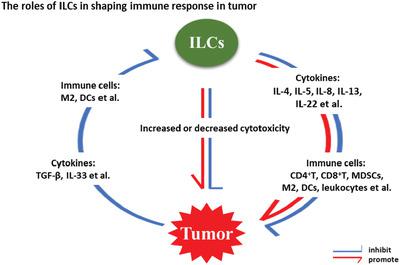当前位置:
X-MOL 学术
›
Eur. J. Immunol.
›
论文详情
Our official English website, www.x-mol.net, welcomes your
feedback! (Note: you will need to create a separate account there.)
Innate lymphoid cells and cancer: Role in tumor progression and inhibition
European Journal of Immunology ( IF 4.5 ) Pub Date : 2021-06-29 , DOI: 10.1002/eji.202049033 Xiaodong Yuan 1 , Faiz Rasul 1, 2 , Björn Nashan 1 , Cheng Sun 1, 2, 3
European Journal of Immunology ( IF 4.5 ) Pub Date : 2021-06-29 , DOI: 10.1002/eji.202049033 Xiaodong Yuan 1 , Faiz Rasul 1, 2 , Björn Nashan 1 , Cheng Sun 1, 2, 3
Affiliation

|
Innate lymphoid cells (ILCs), a critical component of the immune system, have recently been nominated as emerging players associated with tumor progression and inhibition. ILCs are classified into five groups: natural killer (NK) cells, ILC1s, ILC2s, ILC3s, and lymphoid tissue inducer (LTis) cells. NK cells and ILC1s are mainly involved in antitumor activities due to their cytotoxic and cytokine production capabilities, respectively. The current understanding of the heterogeneous behavior of ILC2s and ILC3s in tumors is limited and incomplete. Mostly, their dual roles are modulated by their resident tissues, released cytokines, cancer types, and plasticity. Based on overlap RORγt and cytokine expression, the LTi cells were previously considered part of the ILC3s ontogeny, which are essential for the formation of the secondary lymphoid organs during embryogenesis. Indeed, these facts highlight the urgency in understanding the respective mechanisms that shape the phenotypes and responses of ILCs, either on the repressive or proliferative side in the tumor microenvironment (TME). This review aims to provide an updated view of ILCs biology with respect to tumorigenesis, including a description of ILC plasticity, their interaction with other immune cells and communication with components of the TME. Taken together, targeting ILCs for cancer immunotherapy could be a promising approach against tumors that needs to be further study.
中文翻译:

先天淋巴细胞和癌症:在肿瘤进展和抑制中的作用
先天淋巴细胞 (ILC) 是免疫系统的重要组成部分,最近被提名为与肿瘤进展和抑制相关的新兴参与者。ILC 分为五组:自然杀伤 (NK) 细胞、ILC1、ILC2、ILC3 和淋巴组织诱导 (LTis) 细胞。NK 细胞和 ILC1 分别由于其细胞毒性和细胞因子产生能力而主要参与抗肿瘤活性。目前对 ILC2s 和 ILC3s 在肿瘤中的异质行为的理解是有限和不完整的。大多数情况下,它们的双重作用是由它们的常驻组织、释放的细胞因子、癌症类型和可塑性调节的。基于重叠的 RORγt 和细胞因子表达,LTi 细胞以前被认为是 ILC3s 个体发育的一部分,这对于胚胎发生过程中次级淋巴器官的形成至关重要。事实上,这些事实强调了理解形成 ILC 表型和反应的各自机制的紧迫性,无论是在肿瘤微环境 (TME) 的抑制或增殖方面。本综述旨在提供有关肿瘤发生的 ILC 生物学的最新观点,包括对 ILC 可塑性的描述、它们与其他免疫细胞的相互作用以及与 TME 组分的通信。总之,针对 ILC 进行癌症免疫治疗可能是一种有前景的抗肿瘤方法,需要进一步研究。在肿瘤微环境 (TME) 的抑制或增殖方面。本综述旨在提供有关肿瘤发生的 ILC 生物学的最新观点,包括对 ILC 可塑性的描述、它们与其他免疫细胞的相互作用以及与 TME 组分的通信。总之,针对 ILC 进行癌症免疫治疗可能是一种有前景的抗肿瘤方法,需要进一步研究。在肿瘤微环境 (TME) 的抑制或增殖方面。本综述旨在提供有关肿瘤发生的 ILC 生物学的最新观点,包括对 ILC 可塑性的描述、它们与其他免疫细胞的相互作用以及与 TME 组分的通信。总之,针对 ILC 进行癌症免疫治疗可能是一种有前景的抗肿瘤方法,需要进一步研究。
更新日期:2021-09-01
中文翻译:

先天淋巴细胞和癌症:在肿瘤进展和抑制中的作用
先天淋巴细胞 (ILC) 是免疫系统的重要组成部分,最近被提名为与肿瘤进展和抑制相关的新兴参与者。ILC 分为五组:自然杀伤 (NK) 细胞、ILC1、ILC2、ILC3 和淋巴组织诱导 (LTis) 细胞。NK 细胞和 ILC1 分别由于其细胞毒性和细胞因子产生能力而主要参与抗肿瘤活性。目前对 ILC2s 和 ILC3s 在肿瘤中的异质行为的理解是有限和不完整的。大多数情况下,它们的双重作用是由它们的常驻组织、释放的细胞因子、癌症类型和可塑性调节的。基于重叠的 RORγt 和细胞因子表达,LTi 细胞以前被认为是 ILC3s 个体发育的一部分,这对于胚胎发生过程中次级淋巴器官的形成至关重要。事实上,这些事实强调了理解形成 ILC 表型和反应的各自机制的紧迫性,无论是在肿瘤微环境 (TME) 的抑制或增殖方面。本综述旨在提供有关肿瘤发生的 ILC 生物学的最新观点,包括对 ILC 可塑性的描述、它们与其他免疫细胞的相互作用以及与 TME 组分的通信。总之,针对 ILC 进行癌症免疫治疗可能是一种有前景的抗肿瘤方法,需要进一步研究。在肿瘤微环境 (TME) 的抑制或增殖方面。本综述旨在提供有关肿瘤发生的 ILC 生物学的最新观点,包括对 ILC 可塑性的描述、它们与其他免疫细胞的相互作用以及与 TME 组分的通信。总之,针对 ILC 进行癌症免疫治疗可能是一种有前景的抗肿瘤方法,需要进一步研究。在肿瘤微环境 (TME) 的抑制或增殖方面。本综述旨在提供有关肿瘤发生的 ILC 生物学的最新观点,包括对 ILC 可塑性的描述、它们与其他免疫细胞的相互作用以及与 TME 组分的通信。总之,针对 ILC 进行癌症免疫治疗可能是一种有前景的抗肿瘤方法,需要进一步研究。











































 京公网安备 11010802027423号
京公网安备 11010802027423号